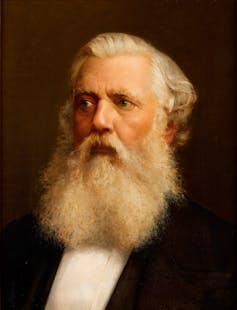Warning: the following article contains spoilers for Beef.
Created by Korean director Lee Sung Jin and starring a predominantly Asian cast, Netflix drama Beef has won plaudits for its gritty yet humorous portrayal of Asian American life.
The show explores racism and cultural appropriation through protagonist Amy Lau’s (Ali Wong) relationship with Jordan Forster (Maria Bello), the mega-rich white businesswoman who purchases her plant business. In one striking scene, Jordan shows off her collection of “exotic” crowns.
Not only does Jordan wear her favourite – one from the Chimú kingdom of ancient Peru – but she bemoans the fact she no longer has the matching earrings. These, she explains with an eye roll, had to be returned to the Peruvian government, implying they were originally stolen. Selfishness and bigotry lurk beneath Jordan’s facade of cosmopolitanism.
But Jordan’s collecting goes beyond priceless artefacts – she collects Asian women too. She tries to use the business deal to get close to Amy, turning her into another beautiful, foreign object in her collection.
Jordan’s other intimate relationship – with Naomi (Ashley Park), who she treats as an accessory as well as an assistant – emphasises her fetishistic interest in Asian women. This dynamic symbolises white western exploitation of ethnic minorities.
It also speaks to sociologist Jean Baudrillard’s claim that “there is something of the harem” about collecting historic artefacts. Beef shows the troubling link between collecting and sexual control.
The history of collecting
The second half of the 19th century was the “age of collecting”. Technological revolutions, international trade and imperialism brought masses of new things to Britain and the west, which were subsequently classified, studied and cherished.

Brits went abroad actively seeking treasures from ancient civilisations. Those that were successful became national heroes. Austen Henry Layard’s plunder from Assyria, for example, was proudly displayed in the British Museum and inspired triumphant novels and plays.
As Britain’s empire expanded and collections deepened, novels dealt with the potentially grim consequences of collectors’ “unruly passions”. These “imperial gothic” stories told of western plunder leading to haunted relics, which wreaked havoc on Brits both at home and in the empire.
In one of the first, Wilkie Collins’ The Moonstone (1868), a precious Indian gem looted by an English army officer brings catastrophe to those that own it. Meanwhile, H. Rider Haggard churned out numerous tales of Egyptian mummies seeking revenge against the daring archaeologists who had disturbed them.

While casting doubt over Britain’s possession of colonial objects, these stories were not a straightforward condemnation of empire. Often, the plucky Brits get off scot-free.
In Haggard’s short story Smith and the Pharaohs (1912-1913), for example, resurrected pharaohs contemplate murdering an archaeologist for tomb violation. They let him go, however, as he is conveniently recognised as the reincarnation of an ancient sculptor, and he safely returns to England with spoils in his pocket.
Written at the high point of imperialism – and in the case of Haggard, by someone who had worked in an official colonial capacity – these tales reflect the imperialistic attitudes of the time. Loot was morally questionable, but the empire itself was not.
From Indiana Jones to Black Panther
The imperial gothic genre found new life in late 20th-century Hollywood. Set in India in the 1930s, Indiana Jones and The Temple of Doom (1984) depicts British colonial authorities as hapless and America as the hero. India is portrayed as a place of poverty, superstition and dark forces.
Jones is accused of looting by the prime minister of the Maharajah of Pankot, but this is quickly brushed over. It is the prime minister’s complicity in taking a sacred stone that causes actual destruction.

Jones’s role in getting the stone back for the innocent Indian civilians reflects the post-second world war and cold war climate for American humanitarian heroes. And it is a similar story in The Mummy (1999), where villainy is shared between American treasure hunters and the sinister Arabs and mummies. The heroes are a team of Americans and Brits who shoot their way to safety. The 2017 reboot of the franchise stars Tom Cruise as an Indiana Jones wannabe – a lovable US army rogue who sells Iraqi loot.
However, Beef and other contemporary projects, such as Marvel’s Black Panther (2018), have punctured this dominant narrative of western saviours of foreign cultures. The museum heist scene in Black Panther showed a descendant from the fictional African country Wakanda rescuing looted treasures from a British museum, in a thinly-veiled critique of the British Museum’s Benin bronzes.
As long as objects have been plundered, countries have called for their repatriation. Yet western popular culture has muted these voices, sometimes expressing anxiety over colonial plunder but ultimately reaffirming British and American supremacy.
Of course, the story is told differently in other contexts. The Chinese film The Opium War (1999), for instance, shows the brutal sacking of the Chinese Summer Palace in 1860. But it is only since ethnic minorities have gained a foothold in mainstream English language media that western audiences have finally been confronted with unequivocal condemnations of their countries’ past offences.

